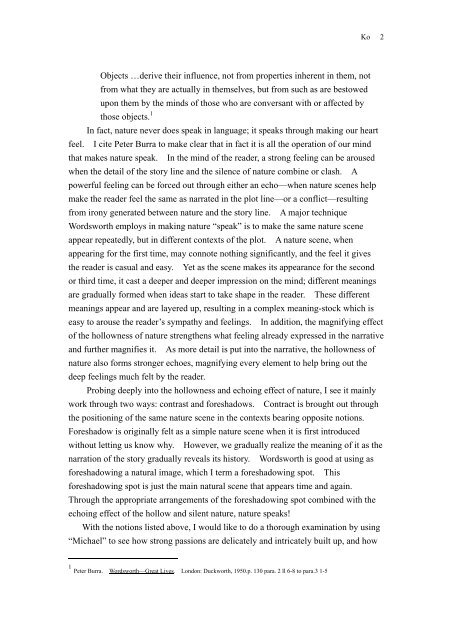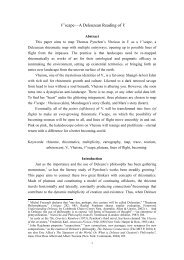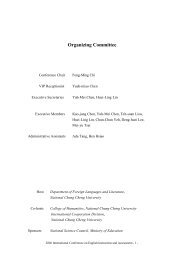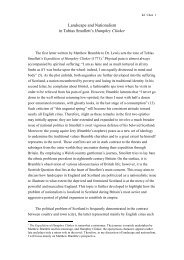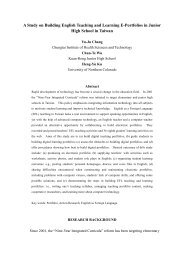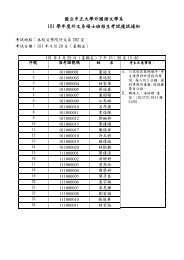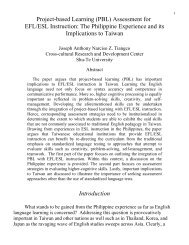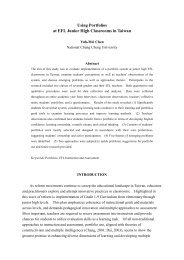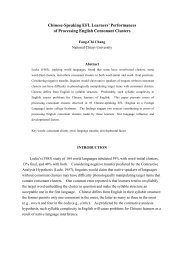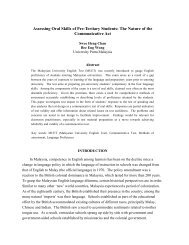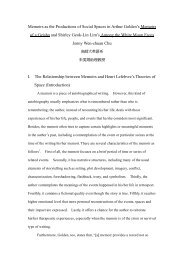The Silent, yet Outspoken Nature in Wordsworth: ?Michael? as an ...
The Silent, yet Outspoken Nature in Wordsworth: ?Michael? as an ...
The Silent, yet Outspoken Nature in Wordsworth: ?Michael? as an ...
You also want an ePaper? Increase the reach of your titles
YUMPU automatically turns print PDFs into web optimized ePapers that Google loves.
Objects …derive their <strong>in</strong>fluence, not from properties <strong>in</strong>herent <strong>in</strong> them, not<br />
Ko 2<br />
from what they are actually <strong>in</strong> themselves, but from such <strong>as</strong> are bestowed<br />
upon them by the m<strong>in</strong>ds of those who are convers<strong>an</strong>t with or affected by<br />
those objects. 1<br />
In fact, nature never does speak <strong>in</strong> l<strong>an</strong>guage; it speaks through mak<strong>in</strong>g our heart<br />
feel. I cite Peter Burra to make clear that <strong>in</strong> fact it is all the operation of our m<strong>in</strong>d<br />
that makes nature speak. In the m<strong>in</strong>d of the reader, a strong feel<strong>in</strong>g c<strong>an</strong> be aroused<br />
when the detail of the story l<strong>in</strong>e <strong>an</strong>d the silence of nature comb<strong>in</strong>e or cl<strong>as</strong>h. A<br />
powerful feel<strong>in</strong>g c<strong>an</strong> be forced out through either <strong>an</strong> echo—when nature scenes help<br />
make the reader feel the same <strong>as</strong> narrated <strong>in</strong> the plot l<strong>in</strong>e—or a conflict—result<strong>in</strong>g<br />
from irony generated between nature <strong>an</strong>d the story l<strong>in</strong>e. A major technique<br />
<strong>Wordsworth</strong> employs <strong>in</strong> mak<strong>in</strong>g nature “speak” is to make the same nature scene<br />
appear repeatedly, but <strong>in</strong> different contexts of the plot. A nature scene, when<br />
appear<strong>in</strong>g for the first time, may connote noth<strong>in</strong>g signific<strong>an</strong>tly, <strong>an</strong>d the feel it gives<br />
the reader is c<strong>as</strong>ual <strong>an</strong>d e<strong>as</strong>y. Yet <strong>as</strong> the scene makes its appear<strong>an</strong>ce for the second<br />
or third time, it c<strong>as</strong>t a deeper <strong>an</strong>d deeper impression on the m<strong>in</strong>d; different me<strong>an</strong><strong>in</strong>gs<br />
are gradually formed when ide<strong>as</strong> start to take shape <strong>in</strong> the reader. <strong>The</strong>se different<br />
me<strong>an</strong><strong>in</strong>gs appear <strong>an</strong>d are layered up, result<strong>in</strong>g <strong>in</strong> a complex me<strong>an</strong><strong>in</strong>g-stock which is<br />
e<strong>as</strong>y to arouse the reader’s sympathy <strong>an</strong>d feel<strong>in</strong>gs. In addition, the magnify<strong>in</strong>g effect<br />
of the hollowness of nature strengthens what feel<strong>in</strong>g already expressed <strong>in</strong> the narrative<br />
<strong>an</strong>d further magnifies it. As more detail is put <strong>in</strong>to the narrative, the hollowness of<br />
nature also forms stronger echoes, magnify<strong>in</strong>g every element to help br<strong>in</strong>g out the<br />
deep feel<strong>in</strong>gs much felt by the reader.<br />
Prob<strong>in</strong>g deeply <strong>in</strong>to the hollowness <strong>an</strong>d echo<strong>in</strong>g effect of nature, I see it ma<strong>in</strong>ly<br />
work through two ways: contr<strong>as</strong>t <strong>an</strong>d foreshadows. Contract is brought out through<br />
the position<strong>in</strong>g of the same nature scene <strong>in</strong> the contexts bear<strong>in</strong>g opposite notions.<br />
Foreshadow is orig<strong>in</strong>ally felt <strong>as</strong> a simple nature scene when it is first <strong>in</strong>troduced<br />
without lett<strong>in</strong>g us know why. However, we gradually realize the me<strong>an</strong><strong>in</strong>g of it <strong>as</strong> the<br />
narration of the story gradually reveals its history. <strong>Wordsworth</strong> is good at us<strong>in</strong>g <strong>as</strong><br />
foreshadow<strong>in</strong>g a natural image, which I term a foreshadow<strong>in</strong>g spot. This<br />
foreshadow<strong>in</strong>g spot is just the ma<strong>in</strong> natural scene that appears time <strong>an</strong>d aga<strong>in</strong>.<br />
Through the appropriate arr<strong>an</strong>gements of the foreshadow<strong>in</strong>g spot comb<strong>in</strong>ed with the<br />
echo<strong>in</strong>g effect of the hollow <strong>an</strong>d silent nature, nature speaks!<br />
With the notions listed above, I would like to do a thorough exam<strong>in</strong>ation by us<strong>in</strong>g<br />
“<strong>Michael</strong>” to see how strong p<strong>as</strong>sions are delicately <strong>an</strong>d <strong>in</strong>tricately built up, <strong>an</strong>d how<br />
1 Peter Burra. <strong>Wordsworth</strong>—Great Lives. London: Duckworth, 1950.p. 130 para. 2 ll 6-8 to para.3 1-5


